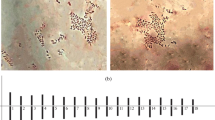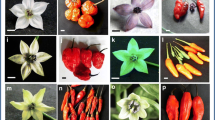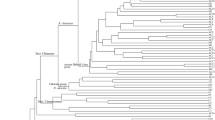Abstract
Wild Rosa resources in Yunnan are very abundant and hold many important and useful traits for improving modern rose. However, many of them have no cytological data and few were karyologically analysed. In this article, karyological study of 24 wild Rosa taxa belonging to different sections was carried out by means of traditional squashing and pressing. The chromosome number of 8 taxa and karyotypes of most studied ones were reported for the first time. 22 resources were diploids with 14 chromosomes (2n = 2x = 14), while Rosa moyesii Hemsl. et Wils. and Rosa macrophylla Lindl. from Sect. Cinnamomeae DC. were hexaploids with 42 chromosomes (2n = 6x = 42). Only type 1A and type 2A been found, karyotypes of genus Rosa in Yunnan were symmetric. Also, the studied taxa differed much from each other in chromosome length, position of centromere, satellite position and satellite number, etc. The results implied that wild Rosa germplasm in Yunnan were rich in karyologcal diversity, and polyploidization might have played and were still playing very important roles in the evolution and speciation in genus Rosa, mainly in Sect. Cinnamomeae in alpine areas of northwestern Yunnan. The cytological data would supply chromosomal proofs not only for the taxonomy, phylogeny and evolution of genus Rosa in this special geological area, but also for the exploitation of useful traits of wild Rosa into the breeding of new cultivars.



Similar content being viewed by others
References
Abbott RJ, Brochmann C (2003) History and evolution of the arctic flora: in the footsteps of Eric Hulten. Mol Ecol 12:299–313
Akasaka M, Ueda Y, Koba T (2002) Karyotype analysis of wild rose species belonging to septets A by fluorescence in situ hybridization. Chromosom Sci 6:17–26
Akasaka M, Ueda Y, Koba T (2003) Karyotype analysis of wild rose species belonging to septets B, C, and D by molecular cytogenetic method. Breed Sci 53:177–182
Arano H (1963) Cytological studies in subfamily Carduoideae (Compositae) of Japan. Bot Mag Tokyo 76:32–39
Baenziger PS, Russell WK, Graff GL, CampbellL BT (2006) 50 years of crop breeding, genetics and cytology. Crop Sci 46:2230–2244
Bai JR, Zhang QX (2008) Investigation on germplasm resources of Rosa L. in northwest Yunnan (in Chinese with English abstract). J Anhui Agric Sci 36:10847–10850
Boufford DE, Van Dijk PP (2000) South-central China. In: Mittermeier RA, Myers N, Mittermeier CG (eds) Hotspots: earth’s biologically richest and most endangered terrestrial ecoregions, 1st edn. CEMEX, Mexico, pp 338–350
Brichet H (2003) Distribution and ecology/continental Asian and Japan. In: Roberts A, Debener T, Gudin S (eds) Encyclopedia of rose sciences, 1st edn. Elsevier Science, Oxford, pp 204–215
Brochmann C, Brysting AK, Alsos IG, Borgen L, Grundt HH, Scheen AC, Elven R (2004) Polyploidy in arctic plants. Bot J Linn Soc 82:521–536
Chen RY, Song WQ, Li XL, Li MX, Liang GL, Chen CB (2003) Chromosome atlas of major economic plants genome in China (Tomus III): chromosome atlas of garden flowering plants in China. Science Press, Beijing, p 698
Chen G, Sun WB, Sun H (2007) Ploidy variation in Buddleja L. (Buddlejaceae) in the Sino-Himalayan region and its biogeographical implications. Bot J Linn Soc 154:305–312
Crane YM, Byrne DH (2003) Karyology. In: Roberts A, Debener T, Gudin S (eds) Encyclopedia of rose sciences, 1st edn. Elsevier Science, Oxford, pp 267–285
Darlington CD (1942) Vitamin C and chromosome number in Rosa. Nature 150:404
Darlington CD, Wylie AP (1955) Chromosome atlas of flowering plants. Geroge Allan & Unwin Ltd, London, pp 134–138
Editor Board of Vegetation of Yunnan (1987) Vegetation of Yunnan. Science Press, Beijing, pp 1–200
Fernandez-Romero MD, Torres AM, Millan T, Cubero JI, Cabrera A (2001) Physical mapping of ribosomal DNA on several species of the subgenus Rosa. Theor Appl Genet 103:835–838
Grant V (1981) Plant speciation. Columbia University Press, New York, pp 1–528
Hurst CC (1928) Differential polyploidy in the genus Rosa L. Z Indukt Abstammungs- Vererbungsl Supplement 2:866–906
Jian HY, Zhang H, Tang KX, Li SF, Wang QG, Qiu XQ, Yan HJ (2010a) Decaploidy in Rosa praelucens Byhouwer (Rosaceae) Endemic to Zhongdian Plateau, Yunnan. China. Caryologia 63(2):162–167
Jian HY, Zhang H, Zhang T, Li SF, Wang QG, Qiu XQ, Yan HJ, Tang KX (2010b) Karyotype analysis of different varieties of Rosa odorata Sweet. J Plant Genet Res 11(4):457–461
Ku TC, Robertson KR (2003) Rosa (Rosaceae). In: Wu ZY, Raven PH(eds) Flora of China, vol 9. Science Press, Beijing, Missouri Botanical Garden Press, St. Louis, pp 339–381
Kuo SR, Wang TT, Huang TC (1972) Karyotype analysis of some formosana gymnosperms. Taiwania 17(1):66–80
Lespinasse Y, Alston FH, Watkins R (1976) Cytological techniques for use in apple breeding. Ann Appl Biol 82:349
Levan A, Fredga K, Sandberg A (1964) Nomenclature for centromeric position on chromosomes. Hereditas 52:201–220
Levin DA (2002) The role of chromosomal change in plant evolution. Oxford University Press, New York, pp 1–216
Liu DH, Li MX (1985) A study on karyotypes of some flowers of Rosa in China (in Chinese with English abstract). J Wuhan Bot Res 3:403–408
Liu CY, Wang GL, Xie QL, Jin J, Liu GN (2008) An study on the chromosome karyomorphology of 6 species in Rosa. J Jiangsu For Sci Tech 35(6):5–8
Ma Y, Chen JY (1991) Chromosome studies of seven roses (in Chinese with English abstract). J Fujian For Coll 11:215–218
Ma Y, Chen JY (1992) Chromosomes studies of six species of Rosa in China (in Chinese with English abstract). Guihaia 12:333–336
Ma Y, Crane CF, Byrne DH (1997a) Karyotypic relationships among some Rosa species. Caryologia 50:317–326
Ma Y, Islam-Faridi MN, Crane CF, Yi Y, Stelly DM, Price HJ, Byrne DH (1997b) In situ hybridization of ribosomal DNA to rose chromosomes. J Hered 88:158–161
Nie ZL, Wen J, Gu ZJ, Boufford DE, Sun H (2005) Polyploidy in the flora of the Hengduan Mountains hotspot, southwestern China. Ann Mo Bot Gard 92:275–306
Ohba H (1988) The alpine flora of the Nepal Himalayas: an introductory note. In: Ohba H, Malla SH (eds) The Himalayan plants, vol 1. Tokyo University Press, Tokyo, pp 19–46
Price L, Short KC, Roberts AV (1981) Poor resolution of C-bands and the presence of B-chromosomes in Rosa rugosa ‘scabrosa’. Caryologia 34:69–72
Qiu XQ, Zhang H, Li SF, Jian HY, Tang KX (2009) Relative relationships analysis of rose germplasm in Yunnan based on SSR markers. Acta Bot Boreal Occident Sin 29(9):1764–1771
Roberts AV, Gladis T, Brumme H (2009) DNA amounts of roses (Rosa L.) and their use in attributing ploidy levels. Plant Cell Rep 28:61–71
Rowley GD (1967) Chromosome studies and evolution in Rosa. B Jard bot nat Belg 37:45–62
Schuster M (1996) Cytogenetics in fruit breeding preparation methods mitotic chromosomes. Gartenbauwiss 61:273–275
Singh R, Singh A, Koul AK, Wafai BA (1984) Chromosome inventory of some Rosaceous fruits cultivars of Kashmir Valley. Chrom Inform Serv 36:7–9
Song RJ, Li HQ (1989) Analyses on karyotypes of Roxburgh rose. Acta Bot Sin 31:155–157
Song WQ, Li XL, Chen YL (1989) Studies on the karyotype evolution and relationship of Maloideae. In: Hong D (ed) Plant chromosome research. Science Press, Beijing, pp 327–333
Soodan AS, Koul AK, Wafai BA (1988) Assessment of the germplasm of Rosaceous fruits under cultivation in Kashmir Valley II. Meiotic system and pollen production in almond, peach and their hybrids. Citología 53:665–670
Stebbins GL (1971) Chromosome evolution in higher plants. Edward Arnold, London, pp 1–216
Täckholm G (1920) On the cytology of the genus Rosa. A preliminary note. Svensk Bot Tidskr 14:300–311
Täckholm G (1922) Zytologische studien uber die Gattung Rosa. Acta Horti Berginani 7:97–381
Tanaka R (1971) Types of resting nuclei in Orchidaceae. Bot Mag Tokyo 84:118–122
Tanaka R (1977) Recent karyotype studies. In: Ogawa K, Kurosumi I, Koike S, Sato M (eds) Plant cytology. Asakura, Tokyo, pp 293–326
Tang KX, Qiu XQ, Zhang H, Li SF, Wang QG, Jian HY, Yan B, Huang XQ (2008) Study on genetic diversity of some Rosa germplasm in Yunnan based on SSR markers. Acta Hortic Sin 35(8):1227–1232
Wissemann V, Ritz CM (2005) The genus Rosa (Rosoideae, Rosaceae) revisited: molecular analysis of nrITS-1 and atpB-rbcL intergenic spacer (IGS) versus conventional taxonomy. Bot J Linn Soc 147:275–290
Wylie AP (1954) The history of garden roses. J Roy Hort Soc 79:555–571
Yan HJ, Zhang H, Wang QG, Jian HY, Qiu XQ, Wang JH, Tang KX (2011) Isolation and identification of a putative scent-related gene RhMYB1 from rose. Mol Biol Rep 38:4475–4482
Yuan Q, Yang QE (2008) Low incidence of polyploids and high uniformity of karyotypes displayed by Delphinium (Ranunculaceae) in the Hengduan Mountains region of south-west China. Bot J Linn Soc 158:172–188
Zhang H, Tang KX, Li SF, Lu L, Li H, Zheng L (2006) Cross fruitfulness of some cut flower cultivars of cut rose. Southwest China J Agric Sci 28(3):442–446
Zhang H, Yang XM, Wang JH, Qu SP, Li SF, Tang KX (2009) Leaf disc assays of resistance of some Rosa germplasms to the powdery mildew in Yunnan. Plant Prot 35(4):131–133
Acknowledgments
We thank ShuFa Li for collecting and grafting some plant materials, XianQin Qiu, HuiJun Yan and NingNing Zhou for all kinds of helps in daily and lab works, Jihua Wang and Shuping Qü for constructive suggestion. This study was supported by the National Natural Science Foundation of China (Grant No. 31060267), Natural Science Foundation of Yunnan Province (2008CD183) and Key Natural Science Foundation of Yunnan Province (2007C0004Z).
Author information
Authors and Affiliations
Corresponding author
Rights and permissions
About this article
Cite this article
Jian, H.Y., Zhang, T., Wang, Q.G. et al. Karyological diversity of wild Rosa in Yunnan, southwestern China. Genet Resour Crop Evol 60, 115–127 (2013). https://doi.org/10.1007/s10722-012-9820-z
Received:
Accepted:
Published:
Issue Date:
DOI: https://doi.org/10.1007/s10722-012-9820-z




